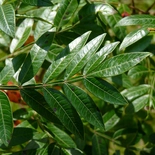The Northeast is renowned for its fall color – the reds and golds of maples, the yellows of clethra and spicebush, the ruby glow of blueberry and chokeberry bushes. And, since its introduction to the United States, from Asia in the 1860s, the gaudy red of burning bush (Euonymus alata), also known as winged euonymus, winged wahoo, winged spindle-tree, or Japanese spindle-tree, has established itself as part of our fall color. As a young homeowner, I, too, craved that fall color, and it was one of the first shrubs I planted. But when I learned about the threats to ecosystems posed by invasive plants like burning bush, it was one of the first I yanked out.
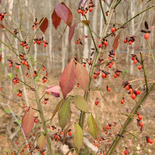
Burningbush(Euonymus alatus)
Burning bush is ubiquitous in my part of the country, found in yards, commercial areas, and public places – sometimes just a bush or two, but often in long hedges. Literally hundreds outline a nearby public park. I’ve even seen it planted in the landscaped areas of our state parks – places that should instead be showcasing our own indigenous plants that support our wildlife.
Like many non-native plants, it has no serious pests, and can tolerate a wide range of growing conditions, including full shade. This adaptability is one of the reasons for its popularity and, by the same token, for its invasive potential. Unfortunately, its popularity also makes its escape into natural areas all the more possible. The bush spreads in its immediate vicinity by means of the “seed shadow,” the blanket of seedlings that germinate right below the parent plant. Berry-eating birds also disperse the seeds to new areas through their droppings. Dense thickets of burning bush shade and crowd out native plants, threatening woodlands, fields, prairies, and coastal scrubland.
So far, its movement into natural areas has been most notable in Connecticut, Virginia, Pennsylvania, and Illinois, but it’s found throughout New England, south to northern Florida and the Gulf Coast, and west to Iowa and Missouri. It has even been reported in Montana. Because of its expansion, it has earned a place on the Red Alert list compiled by The Nature Conservancy’s Global Invasive Species Team.
But – suggest that burning bush may not be a good landscape choice, and you may encounter resistance – even hostility. People love the fall color. Unlike other invasives, like garlic mustard or Japanese knotweed, they are not likely to have noticed it invading nearby natural areas. As anyone who has tried to control a plant invasion will tell you, the time to manage it is before it becomes an obvious problem, not after.
To eradicate burning bushes, you can hand-pull seedlings that may have sprouted nearby and dig up the parent plant if it’s not too big. For the larger specimen, this can be 18-feet tall and wide – just keep cutting it to the ground until it gives up. For large infestations, you’ll probably need to resort to systemic herbicides, carefully following directions for either cut-stump or foliar treatment.
Those still not convinced of burning bush’s ecological dangers might nevertheless be lured away from the plant by discovering the many beautiful native alternatives (see box below). Burning bush in the fall may be eyecatching, but even devotees have to admit that it’s downright plain the rest of the year. On the other hand, many native shrubs not only provide vibrant fall color, but have other good qualities throughout the year: More attractive foliage, flowers, and berries. Further, you’ll have a distinctive landscape: The only one on your block without a burning bush.
Some Native Alternatives to Burning Bush
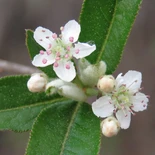
Red Chokeberry(Aronia arbutifolia)

Virginia Sweetspire(Itea virginica)
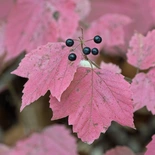
Mapleleaf Viburnum(Viburnum acerifolium)

Highbush Blueberry(Vaccinium corymbosum)

Silky Dogwood(Cornus amomum)
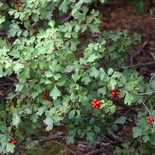
Fragrant Sumac(Rhus aromatica)
